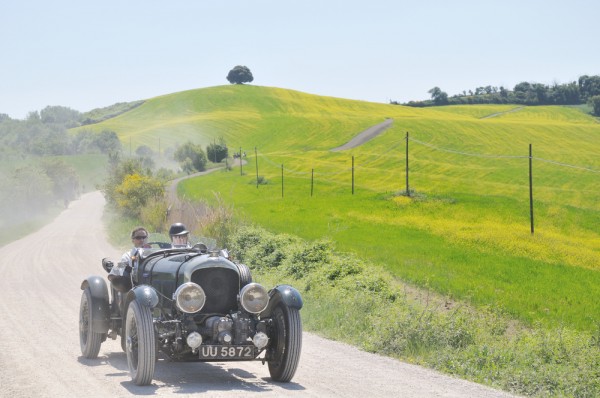Iconic Car of the Month: Bentley Blower
by Dan Hackett
15/07/2016 15:26
Share

Iconic Car of the Month: Bentley Blower
For this month’s Iconic Car feature, Bristol Street Motors will be stepping back in time to the glory days of British racing, that sepia-toned time of giant racing goggles, soot-covered faces, and an attitude towards safety that was blas� at best and often veered towards downright maniacal. This was an age of rugged vehicles and humankind’s unrelenting pursuit of automotive power and speed – and this month’s Iconic Car is the epitome of the whole era. May we present to you the most British car you’ll ever lay eyes on, the race winning, heart capturing, Bentley Blower.
To tell the story of the Bentley 4� Blower, it�s also necessary to tell the story of its owner, Sir Henry “Tim” Birkin, hero of schoolboys everywhere and the sweetheart of the nation throughout the roaring twenties. Once described as “the greatest Briton of his time” by W.O. Bentley, the company’s chief engineer, Birkin was an aristocrat who had fought in the First World War and returned home with a thirst for adrenaline and a complete disregard for danger.
The public followed the news of his madcap exploits with reverence. In 1928, he completed Le Mans with a lap with an average speed of 85mph � despite the fact that one of his tyres had blown, and he was racing on three wheels. Another story goes that Sir Henry drove the Blower up the main staircase of the Savoy Hotel during a glamorous dinner. Rarely if ever in history has a person been so intrinsically linked to a vehicle. Pope Francis has the Popemobile, the Queen has her Land Rover Defender, and Birkin had the Blower.
The Bentley Blower is a supercharged version of the classic Bentley 4� litre, which was first produced in 1927, with 720 being made before its discontinuation in 1931. The Bentley 4� was, like other Bentleys, mainly purchased by buyers for use as personal transportation. It came in a variety of body styles; usually saloons or tourers. Before he ever got ejector seats installed in his Aston Martin, James Bond drove a Bentley, with the car appearing in the original Casino Royale novel.
Publicity for the car was most notably increased by its participation in high profile races such as Le Mans, competing against rivals including Bugatti and Lorraine-Dietrich. It was a widely acknowledged fact that a victory in such a race massively boosted a carmakers reputation. Throughout the 1920’s, a dedicated group arose, earning adoration from the British public. The ‘Bentley Boys’ were a group of well-to-do daredevils who rocketed Bentley to motoring fame and notoriety with their racing achievements. British financier Woolf Barnato was one such Bentley Boy, and when the brand faltered financially in the 1925, Barnato purchased the company. The purchasing of the car manufacturer by a fabulously wealthy speed demon was a key factor in the development of the supercharged Bentley 4� – the Blower.
Out of the 720 4� Litres produced, 55 of these were supercharged, with a Roots-type supercharger added by engineer Amherst Villiers. However, chief engineer and company founder W.O. Bentley refused to allow the engine to be modified, which meant they had to find a different way to incorporate the supercharger. The solution was to place the supercharger in front of the crank shaft and radiator grille � giving the car its completely unique, slightly-unfinished, mechanical appearance. This also influenced the cars handling, as the weight of the car was now distributed more toward the front. In a car as enormous as the Blower, 14ft and 4.4 inches long, the extra weight meant the car had a tendency to understeer.
Sir Henry Birkin and his Blower, named ‘No. 1′, raced together for several adventure packed years. In 1929, Sir Henry entered a 500 mile endurance race, continuing to race even after a cracked exhaust caused a fire on board. In the 1930 24 Hours of Le Mans, he famously overtook the Mercedes Benz SSK of formidable race driver Rudolf Caracciola, driving over grass at 125 mph despite throwing a tyre tread. The Blower’s finest hour came at the French Grand Prix when Sir Henry beat almost the entire Bugatti line up, in what is considered his greatest ever race, despite coming second place. The incident lead a red-face Ettore Bugatti to heckle Bentley as “the fastest trucks in the world”.
The Blower No.1 won Le Mans twice, in 1929 and 1931, with its faithful companion Sir Henry at the wheel. Sir Henry ‘Tim’ Birkin passed away in 1933, and the Blower No.1 was auctioned to watchmaker George Daniels. In 2012, the car was sold to an unnamed bidder for £5,042,000, which makes it the most expensive British-built car ever sold. With such an illustrious history behind it, it’s not hard to see why.